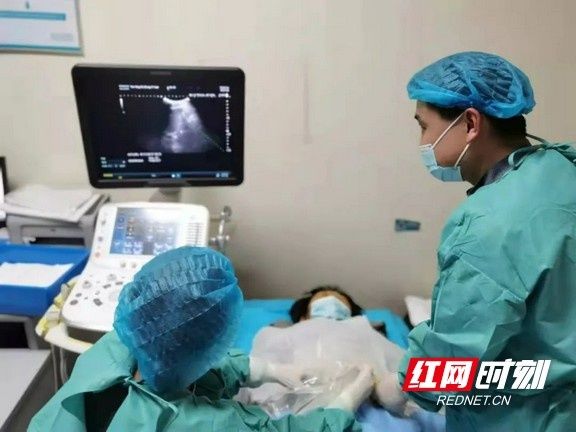
Surgery site.
Recently, 71-year-old Lu Yuyu successfully completed the “Ultrasound-Guided Percutaneous Hepatic Hepatectomy” in the Ultrasound Interventional Clinic of Yueyang Traditional Chinese Medicine Hospital due to severe stenosis at the end of the common duct and common hepatic duct, and dilation of the extrahepatic and extrahepatic bile ducts and the main pancreatic duct. Internal bile duct puncture and drainage”, the patient’s condition improved significantly after operation. This is the first patient treated by the Ultrasound Interventional Clinic of the Ultrasound Medicine Department of the Municipal Hospital of Traditional Chinese Medicine. It marks the completion of the Ultrasound Interventional Clinic of the Yueyang Traditional Chinese Medicine Hospital, and the functional department has successfully entered a new path of development from a simple examination to a combination of ultrasound diagnosis and treatment. technology era.
Patient Lv Yuyu, female, 71 years old, was diagnosed with choledocholithiasis with cholangitis and cholecystolithiasis with cholecystitis 3 months ago, and underwent laparoscopic choledocholithotomy + choledochoscopy + cholecystectomy in a hospital In the past 2 months, he developed symptoms such as severe yellowing of the skin and sclera, as well as severe liver function damage. He was transferred to the Municipal Traditional Chinese Medicine Hospital for treatment, and underwent MRCP + plain CT enhanced examination of the pancreatic and bile ducts. Combined with clinical symptoms, the diagnosis of the end of the common bile duct and liver Severe stenosis at the end of the common duct, dilation of the intrahepatic and extrahepatic bile ducts and the main pancreatic duct. After consultation with the Department of Ultrasound Medicine and the Third Department of Surgery, they agreed that: the patient is older, the disease is serious, the risk of surgery is high, and there are many postoperative complications. After a comprehensive evaluation of the patient’s condition, it was decided to perform “ultrasound-guided percutaneous intrahepatic bile duct catheterization and drainage” for the patient.
Before the puncture, Wu Songmei, director of the Department of Ultrasound Medicine, carefully scanned the patient’s intrahepatic bile duct and adjacent blood vessels under the color Doppler ultrasound, analyzed the real-time ultrasound images, and selected the best puncture point and puncture path. The puncture needle was accurate under the guidance of color Doppler ultrasound. The patient’s dilated left intrahepatic bile duct was punctured, and white bile was aspirated with a syringe in less than 1 minute. The operation went smoothly and the patient did not feel any discomfort. On the first day after the operation, the patient improved significantly.
Ultrasound intervention perfectly meets the requirements of precision medicine with precision, minimal invasiveness and safety. Under the monitoring of ultrasound equipment, various puncture biopsies, suction catheters and various treatments can be completed to avoid damage to important organs and blood vessels, which can achieve the same effect as surgery. Ultrasound intervention does not require surgery or perforation, and fine needle aspiration is safe, non-invasive, pain-free, non-recurring, and non-hospital. In order to facilitate patients and meet clinical needs, the Ultrasound Intervention Clinic of the Department of Ultrasound Medicine of the Municipal Hospital of Traditional Chinese Medicine provides diagnosis and treatment for patients around the clock. Patients can go directly to the interventional ultrasound clinic. The ultrasound intervention team will determine whether to perform ultrasound intervention according to the specific situation of the patient, and formulate an individualized interventional treatment plan to provide patients with safe, fast and minimally invasive medical services.
What is Ultrasound Intervention?
Ultrasound intervention is the use of fine needle aspiration under the guidance of ultrasound to directly reach the lesion area, complete various diagnosis or treatment operations, and relieve clinical symptoms.
The main business scope of ultrasound intervention:
1. Tumor biopsy
Including fine needle aspiration biopsy of thyroid nodules, breast Biopsy of nodules, liver and kidney tumors, prostate, body surface masses, etc.
2. Puncture and drainage
Percutaneous hepatobiliary drainage, gallbladder drainage, nephrostomy, pleural effusion, pericardial effusion, hydronephrosis/pyometrium, abdominal abscess Intubation drainage. Ovarian chocolate cyst, liver cyst, renal cyst sclerosis, etc.
3. Ablation
Minimally invasive treatment of thyroid nodules, liver tumors and tumors in other regions.
4. Pain treatment
Interventional minimally invasive treatment of muscle, tendon, fascia, and peripheral nerve pain. Such as joint pain, limb numbness, etc.
5, transesophageal echocardiography and right heart angiography. (Correspondent Pan Zhenghui)